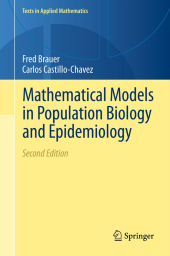 Neuerscheinungen 2014Stand: 2020-02-01 |
Schnellsuche
ISBN/Stichwort/Autor
|
Herderstraße 10
10625 Berlin
Tel.: 030 315 714 16
Fax 030 315 714 14
info@buchspektrum.de |

Dawn Bies, Fred Brauer
(Beteiligte)
Mathematical Models in Population Biology and Epidemiology
2. Aufl. 2014. xxiv, 508 S. 235 mm
Verlag/Jahr: SPRINGER, BERLIN; SPRINGER NEW YORK 2014
ISBN: 1-489-99398-3 (1489993983)
Neue ISBN: 978-1-489-99398-4 (9781489993984)
Preis und Lieferzeit: Bitte klicken
This book balances theory and application in the use of mathemathical models for addressing questions in epidemiology and population studies. This latest revised edition makes extensive use of both examples and exercise problems throughout the text.
The goal of this book is to search for a balance between simple and analyzable models and unsolvable models which are capable of addressing important questions on population biology. Part I focusses on single species simple models including those which have been used to predict the growth of human and animal population in the past. Single population models are, in some sense, the building blocks of more realistic models -- the subject of Part II. Their role is fundamental to the study of ecological and demographic processes including the role of population structure and spatial heterogeneity -- the subject of Part III. This book, which will include both examples and exercises, is of use to practitioners, graduate students, and scientists working in the field.
Preface Ackn. Prologue Part I: Simple Single-Species Models 1 Continuous Population Models 2 Discrete Population Models 3 Continuous single-species Population Models with Delays Part II: Models for Interacting Species 4 Introduction and Mathematical Preliminaries 5 Continuous models for two interacting populations 6 Harvesting in two-species models Part III: Structured Population Models 7 Basic ideas of Mathematical Epidemiology 8 Models for population with age structure Epilogue Answers to selected Exercises References
Fred Brauer, Department of Mathematics, University of British Columbia, Canada; Carlos Castillo-Chavez, Mathematical, Computational and Modeling Sciences Center, Arizona State University, USA


